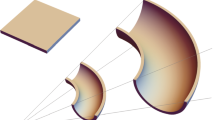Abstract
The notion of material symmetry has been formalised by W. Noll and Truesdell’s school of continuum mechanics, and is now explained in many classical textbooks. Mostly, attention has been confined to simple materials. Applying the notion to shells requires to consider second-grade continua and is more concealed. Attempts have been done among others by Murdoch and Cohen, Steigmann and Ogden, Steigmann. Here I present an independent approach for hyper-elastic shells with second-gradient elasticity. The equation that characterizes the material symmetries is deduced and, by way of illustration, the case of a shell with unstressed reference configuration is discussed.
Similar content being viewed by others
Notes
We stipulate that all the bases introduced hereafter are right-handed bases.
To simplify notation we write \(\vartheta \) for the pairs \((\vartheta ^{1},\vartheta ^{2})\) in the sequel. Furthermore, we assume that \(\mathfrak{h}\) is differentiable as much as needed, so that \(\vartheta '(\vartheta )\) is also so.
Or better, turns out to be.
Recall that \(\nabla \mathfrak{h}\) is a two-by-two tensor, so both signs are compatible with \(\text{(6.2)}_{1}\).
References
Noll, W.: A mathematical theory of the mechanical behavior of continuous media. Arch. Rational. Mech. Anal. 2, 197–226 (1958)
Truesdell, C.: The Elements of Continuum Mechanics. Springer, New York (1966)
Carroll, M.M., Naghdi, P.M.: The influence of the reference geometry on the response of elastic shells. Arch. Ration. Mech. Anal. 48, 302–318 (1972)
Ericksen, J.L.: Apparent symmetry of certain thin elastic shells. J. Méc. 12, 173–181 (1973)
Steigmann, D.J.: Equilibrium of elastic lattice shells. J. Eng. Math. 109, 47–61 (2018). https://doi.org/10.1007/s10665-017-9905-y
Murdoch, A.I., Cohen, H.: Symmetry considerations for material surfaces. Arch. Rational. Mech. Anal. 72, 61–98 (1979). Addendum, Arch. Ration. Mech. Anal. 76, 393–400 (1981)
Steigmann, D.J., Ogden, R.W.: Elastic surface-substrate interactions. Proc. R. Soc. Lond. A 455, 437–474 (1999)
Lovelock, D., Rund, H.: Tensors, Differential Forms and Variational Principles. Dover, New York (1989)
Acknowledgement
I wish to thank David Steigmann for kind discussions.
Author information
Authors and Affiliations
Corresponding author
Additional information
Publisher’s Note
Springer Nature remains neutral with regard to jurisdictional claims in published maps and institutional affiliations.
Rights and permissions
About this article
Cite this article
Davini, C. Material Symmetry of Elastic Shells. J Elast 138, 77–91 (2020). https://doi.org/10.1007/s10659-019-09726-y
Received:
Published:
Issue Date:
DOI: https://doi.org/10.1007/s10659-019-09726-y



